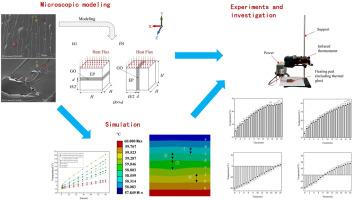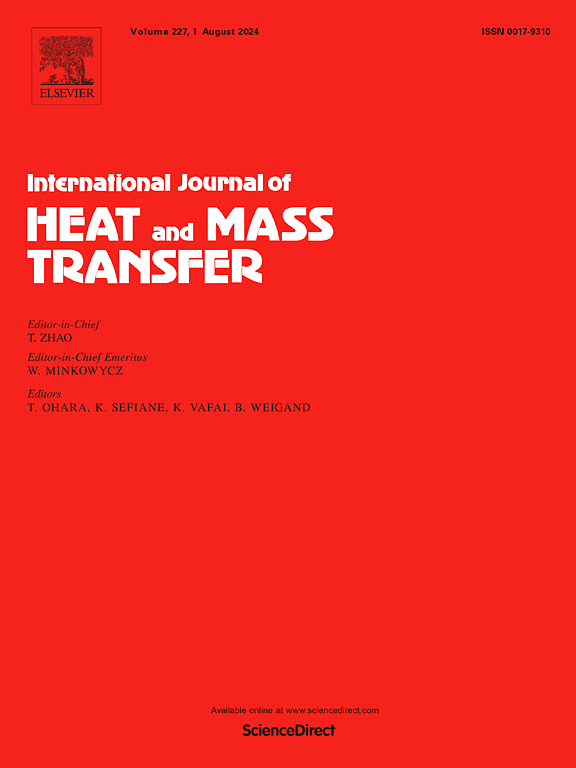二维排列的 GO/EP 复合材料的传热性能研究
IF 5
2区 工程技术
Q1 ENGINEERING, MECHANICAL
International Journal of Heat and Mass Transfer
Pub Date : 2024-11-14
DOI:10.1016/j.ijheatmasstransfer.2024.126427
引用次数: 0
摘要
高空飞机很容易因过冷液滴而结冰,从而危及飞行安全。为解决这一问题,我们采用了一种新方法,即利用电磁场耦合合成二维对齐氧化石墨烯/环氧树脂(GO/EP)复合材料。与未对齐的氧化石墨烯/环氧树脂复合材料相比,其热导率明显提高了 5%,与纯环氧树脂相比提高了 5.7%,从而提高了电加热除冰系统的效率。根据热阻和等效热导率原理,建立了二维对齐 GO/EP 复合材料的数学传热模型,并通过引入参数 "m",建立了 GO/EP 的优化有效介质理论传热模型,从而有效地预测了复合材料的热导率。实验和模拟研究都证实了热导率的显著提高。经计算,对齐的 GO/EP 复合材料内的有效传热路径长度比未对齐的复合材料长 41.4%,这表明热传导路径更有效。该研究表明,将氧化石墨烯融入环氧树脂可形成导热通道,提高热传导效率。二维氧化石墨烯通道的排列优化了导热性,无需增加掺杂,为防冰/除冰应用中的高导热复合材料提供了一种解决方案。这项创新有望对未来的飞机除冰技术产生影响。本文章由计算机程序翻译,如有差异,请以英文原文为准。

Heat transfer performance investigation on two-dimensional aligned GO/EP composites
High-altitude aircraft are susceptible to icing due to supercooled droplets, which can compromise flight safety. To address this, a novel approach was taken by leveraging electromagnetic field coupling to synthesize two-dimensional aligned graphene oxide/epoxy resin (GO/EP) composites. The thermal conductivity was significantly enhanced by 5 % over non-aligned GO/EP composites and by 5.7 % over pure EP, thereby improving the efficiency of electric heating de-icing systems. A mathematical heat transfer model was developed for the two-dimensional aligned GO/EP composite, based on the principles of thermal resistance and equivalent thermal conductivity, an optimized effective medium theory heat transfer model for GO/EP was established by introducing the parameter "m", which effectively predicting the thermal conductivity of composites. Both experimental and simulation studies confirmed a notable increase in thermal conductivity. The effective heat transfer path length within the aligned GO/EP composite was calculated to be 41.4 % longer than in the non-aligned version, indicating a more efficient heat conduction pathway. The research demonstrates that the integration of graphene oxide into epoxy resin creates thermally conductive channels, boosting heat transfer efficiency. The alignment of two-dimensional GO channels optimizes thermal conductivity without the need for increased doping, presenting a solution for high thermal conductivity composites in anti-/deicing applications. This innovation is expected to have implications for the future of aircraft de-icing technology.
求助全文
通过发布文献求助,成功后即可免费获取论文全文。
去求助
来源期刊
CiteScore
10.30
自引率
13.50%
发文量
1319
审稿时长
41 days
期刊介绍:
International Journal of Heat and Mass Transfer is the vehicle for the exchange of basic ideas in heat and mass transfer between research workers and engineers throughout the world. It focuses on both analytical and experimental research, with an emphasis on contributions which increase the basic understanding of transfer processes and their application to engineering problems.
Topics include:
-New methods of measuring and/or correlating transport-property data
-Energy engineering
-Environmental applications of heat and/or mass transfer

 求助内容:
求助内容: 应助结果提醒方式:
应助结果提醒方式:


